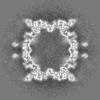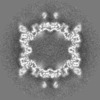+ Open data
Open data
- Basic information
Basic information
| Entry |  | |||||||||
|---|---|---|---|---|---|---|---|---|---|---|
| Title | CPV2a capsid complexed with scFv2 | |||||||||
 Map data Map data | A sharpened-map of CPV2a-scFv2 complex | |||||||||
 Sample Sample |
| |||||||||
 Keywords Keywords | Virus / Antibody / Complex / VIRUS-IMMUNE SYSTEM complex | |||||||||
| Function / homology |  Function and homology information Function and homology informationsymbiont entry into host cell via permeabilization of host membrane / T=1 icosahedral viral capsid / clathrin-dependent endocytosis of virus by host cell / virion attachment to host cell / structural molecule activity Similarity search - Function | |||||||||
| Biological species |  Canine parvovirus 2b / Canine parvovirus 2b /   Canine parvovirus 2a Canine parvovirus 2a | |||||||||
| Method | single particle reconstruction / cryo EM / Resolution: 3.5 Å | |||||||||
 Authors Authors | Lee H / Hafenstein S | |||||||||
| Funding support | 1 items
| |||||||||
 Citation Citation |  Journal: Proc Natl Acad Sci U S A / Year: 2025 Journal: Proc Natl Acad Sci U S A / Year: 2025Title: Structures and functions of the limited natural polyclonal antibody response to parvovirus infection. Authors: Oluwafemi F Adu / Hyunwook Lee / Simon P Früh / Marta V Schoenle / Wendy S Weichert / Andrew I Flyak / Susan L Hafenstein / Colin R Parrish /   Abstract: Host antibody responses are key components in the protection of animals against pathogens, yet the defining properties of viral antigens and induction of B cell responses that result in varied ...Host antibody responses are key components in the protection of animals against pathogens, yet the defining properties of viral antigens and induction of B cell responses that result in varied protection are still poorly understood. Parvoviruses are simple molecular structures that display 60 repeated motifs on their capsid surface, and rapidly induce strong antibody responses that protect animals from infection. We recently showed that following canine parvovirus infection of its natural host, the polyclonal response in the sera contained only two or three dominant antibodies that bound two epitopes on the capsid. Here, we characterize key antibodies present in that immune response, identifying their sequences, defining their binding properties on the capsid by cryoelectron microscopic (cryoEM) analysis, and testing their effects on viral infectivity. Two antibodies sharing the same heavy chain bound to the side of the capsid threefold spike (B-site), while another distinct antibody bound close to the threefold axis (A-site). The epitopes of these antibodies overlapped the binding site of the host receptor, the transferrin receptor type-1, but to varying degrees. The antibodies varied widely in their neutralization efficiencies as either immunoglobulins (IgGs) or monomeric antigen-binding fragments (Fabs), which was consistent with their ability to compete for the receptor. The monoclonal antibodies characterized here matched the structures from the cryoEM analysis of polyclonal sera, including those present in a different dog than the monoclonal source. This shows that after infection, a focused response to the viral antigen is produced that protects against infection. | |||||||||
| History |
|
- Structure visualization
Structure visualization
| Supplemental images |
|---|
- Downloads & links
Downloads & links
-EMDB archive
| Map data |  emd_47711.map.gz emd_47711.map.gz | 309.4 MB |  EMDB map data format EMDB map data format | |
|---|---|---|---|---|
| Header (meta data) |  emd-47711-v30.xml emd-47711-v30.xml emd-47711.xml emd-47711.xml | 20.9 KB 20.9 KB | Display Display |  EMDB header EMDB header |
| FSC (resolution estimation) |  emd_47711_fsc.xml emd_47711_fsc.xml | 20.3 KB | Display |  FSC data file FSC data file |
| Images |  emd_47711.png emd_47711.png | 213.1 KB | ||
| Filedesc metadata |  emd-47711.cif.gz emd-47711.cif.gz | 6.4 KB | ||
| Others |  emd_47711_half_map_1.map.gz emd_47711_half_map_1.map.gz emd_47711_half_map_2.map.gz emd_47711_half_map_2.map.gz | 273.1 MB 273.1 MB | ||
| Archive directory |  http://ftp.pdbj.org/pub/emdb/structures/EMD-47711 http://ftp.pdbj.org/pub/emdb/structures/EMD-47711 ftp://ftp.pdbj.org/pub/emdb/structures/EMD-47711 ftp://ftp.pdbj.org/pub/emdb/structures/EMD-47711 | HTTPS FTP |
-Validation report
| Summary document |  emd_47711_validation.pdf.gz emd_47711_validation.pdf.gz | 1 MB | Display |  EMDB validaton report EMDB validaton report |
|---|---|---|---|---|
| Full document |  emd_47711_full_validation.pdf.gz emd_47711_full_validation.pdf.gz | 1 MB | Display | |
| Data in XML |  emd_47711_validation.xml.gz emd_47711_validation.xml.gz | 23.4 KB | Display | |
| Data in CIF |  emd_47711_validation.cif.gz emd_47711_validation.cif.gz | 31.1 KB | Display | |
| Arichive directory |  https://ftp.pdbj.org/pub/emdb/validation_reports/EMD-47711 https://ftp.pdbj.org/pub/emdb/validation_reports/EMD-47711 ftp://ftp.pdbj.org/pub/emdb/validation_reports/EMD-47711 ftp://ftp.pdbj.org/pub/emdb/validation_reports/EMD-47711 | HTTPS FTP |
-Related structure data
| Related structure data |  9e89MC  9e60C  9e7wC  9e7xC  9e7zC  9e80C  9e8dC M: atomic model generated by this map C: citing same article ( |
|---|---|
| Similar structure data | Similarity search - Function & homology  F&H Search F&H Search |
- Links
Links
| EMDB pages |  EMDB (EBI/PDBe) / EMDB (EBI/PDBe) /  EMDataResource EMDataResource |
|---|---|
| Related items in Molecule of the Month |
- Map
Map
| File |  Download / File: emd_47711.map.gz / Format: CCP4 / Size: 343 MB / Type: IMAGE STORED AS FLOATING POINT NUMBER (4 BYTES) Download / File: emd_47711.map.gz / Format: CCP4 / Size: 343 MB / Type: IMAGE STORED AS FLOATING POINT NUMBER (4 BYTES) | ||||||||||||||||||||||||||||||||||||
|---|---|---|---|---|---|---|---|---|---|---|---|---|---|---|---|---|---|---|---|---|---|---|---|---|---|---|---|---|---|---|---|---|---|---|---|---|---|
| Annotation | A sharpened-map of CPV2a-scFv2 complex | ||||||||||||||||||||||||||||||||||||
| Projections & slices | Image control
Images are generated by Spider. | ||||||||||||||||||||||||||||||||||||
| Voxel size | X=Y=Z: 0.96 Å | ||||||||||||||||||||||||||||||||||||
| Density |
| ||||||||||||||||||||||||||||||||||||
| Symmetry | Space group: 1 | ||||||||||||||||||||||||||||||||||||
| Details | EMDB XML:
|
-Supplemental data
-Half map: Half-map A f the CPV2a-scFv2 complex
| File | emd_47711_half_map_1.map | ||||||||||||
|---|---|---|---|---|---|---|---|---|---|---|---|---|---|
| Annotation | Half-map A f the CPV2a-scFv2 complex | ||||||||||||
| Projections & Slices |
| ||||||||||||
| Density Histograms |
-Half map: Half-map B of the CPV2a-scFv2 complex
| File | emd_47711_half_map_2.map | ||||||||||||
|---|---|---|---|---|---|---|---|---|---|---|---|---|---|
| Annotation | Half-map B of the CPV2a-scFv2 complex | ||||||||||||
| Projections & Slices |
| ||||||||||||
| Density Histograms |
- Sample components
Sample components
-Entire : Canine parvovirus 2a
| Entire | Name:  Canine parvovirus 2a Canine parvovirus 2a |
|---|---|
| Components |
|
-Supramolecule #1: Canine parvovirus 2a
| Supramolecule | Name: Canine parvovirus 2a / type: virus / ID: 1 / Parent: 0 / Macromolecule list: all / NCBI-ID: 497961 / Sci species name: Canine parvovirus 2a / Virus type: VIRION / Virus isolate: STRAIN / Virus enveloped: No / Virus empty: Yes |
|---|
-Macromolecule #1: Capsid protein
| Macromolecule | Name: Capsid protein / type: protein_or_peptide / ID: 1 / Number of copies: 1 / Enantiomer: LEVO |
|---|---|
| Source (natural) | Organism:  Canine parvovirus 2b Canine parvovirus 2b |
| Molecular weight | Theoretical: 64.745559 KDa |
| Recombinant expression | Organism:  |
| Sequence | String: MSDGAVQPDG GQPAVRNERA TGSGNGSGGG GGGGSGGVGI STGTFNNQTE FKFLENGWVY ITANSSRLVH LNMPESENYR RVVVNNLDK TAVNGNMALD DTHAEIVTPW SLVDANAWGV WFNPGDWQLI VNTMSELHLV SFEQEIFNVV LKTVSESATQ P PTKVYNND ...String: MSDGAVQPDG GQPAVRNERA TGSGNGSGGG GGGGSGGVGI STGTFNNQTE FKFLENGWVY ITANSSRLVH LNMPESENYR RVVVNNLDK TAVNGNMALD DTHAEIVTPW SLVDANAWGV WFNPGDWQLI VNTMSELHLV SFEQEIFNVV LKTVSESATQ P PTKVYNND LTASLMVALD SNNTMPFTPA AMRSETLGFY PWKPTIPTPW RYYFQWDRTL IPSHTGTSGT PTNIYHGTDP DD VQFYTIE NSVPVHLLRT GDEFATGTFF FDCKPCRLTH TWQTNRALGL PPFLNSLPQS EGGTNFGYIG VQQDKRRGVT QMG NTNYIT EATIMRPAEV GYSAPYYSFE ASTQGPFKTP IAAGRGGAQT DENQAADGDP RYAFGRQHGQ KTTTTGETPE RFTY IAHQD TGRYPEGDWI QNINFNLPVT DDNVLLPTDP IGGKTGINYT NIFNTYGPLT ALNNVPPVYP NGQIWDKEFD TDLKP RLHV NAPFVCQNNC PGQLFVKVAP NLTNQYDPDA SANMSRIVTY SDFWWKGKLV FKAKLRASHT WNPIQQMSIN VDNQFN YVP SNIGGMKIVY EKSQLAPRKL Y UniProtKB: Capsid protein |
-Macromolecule #2: Light-chain of scFv clone 2
| Macromolecule | Name: Light-chain of scFv clone 2 / type: protein_or_peptide / ID: 2 / Number of copies: 1 / Enantiomer: LEVO |
|---|---|
| Source (natural) | Organism:  |
| Molecular weight | Theoretical: 11.121105 KDa |
| Recombinant expression | Organism:  Trichoplusia ni (cabbage looper) Trichoplusia ni (cabbage looper) |
| Sequence | String: VLTQKASVSG SLGQTITISC TGTSSNIGHN NVGWYQQLPG RGPRTVVSGT NSRPSGVSDR FSASKSGNTA TLTISGLRAD DEADYYCST WDDSLNVVFG GGTHLTVL |
-Macromolecule #3: Heavy-chain of scFv clone 2
| Macromolecule | Name: Heavy-chain of scFv clone 2 / type: protein_or_peptide / ID: 3 / Number of copies: 1 / Enantiomer: LEVO |
|---|---|
| Source (natural) | Organism:  |
| Molecular weight | Theoretical: 14.165727 KDa |
| Recombinant expression | Organism:  Trichoplusia ni (cabbage looper) Trichoplusia ni (cabbage looper) |
| Sequence | String: EVQLVESGGD LVKPGGSLRL SCEASGFTFS NYHMAWVRQA PGKGLQWVAN IDSGGFTTNY VDAVRGRFTV SRDNGALYLQ MNGLRVEDT AVYYCATMKT TYCIDENCNS FQAGRGVFDN WGQGTLVTVS S |
-Experimental details
-Structure determination
| Method | cryo EM |
|---|---|
 Processing Processing | single particle reconstruction |
| Aggregation state | particle |
- Sample preparation
Sample preparation
| Buffer | pH: 7 |
|---|---|
| Vitrification | Cryogen name: ETHANE |
- Electron microscopy
Electron microscopy
| Microscope | FEI TALOS ARCTICA |
|---|---|
| Image recording | Film or detector model: FEI FALCON III (4k x 4k) / Average electron dose: 40.0 e/Å2 |
| Electron beam | Acceleration voltage: 200 kV / Electron source:  FIELD EMISSION GUN FIELD EMISSION GUN |
| Electron optics | Illumination mode: FLOOD BEAM / Imaging mode: BRIGHT FIELD / Nominal defocus max: 2.25 µm / Nominal defocus min: 0.75 µm |
| Experimental equipment | 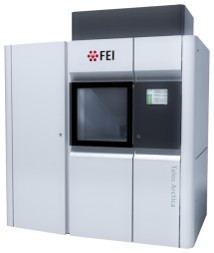 Model: Talos Arctica / Image courtesy: FEI Company |
 Movie
Movie Controller
Controller













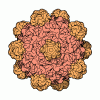
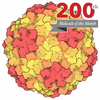
 Z (Sec.)
Z (Sec.) Y (Row.)
Y (Row.) X (Col.)
X (Col.)
























